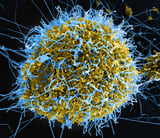1 What is the Ebola Virus?
The Ebola haemorrhagic fever or the Ebola virus disease is a human transmitted disease that is severe and often fatal in humans. The outbreak of the virus has a case fatality rate of up to 90%. The outbreaks also occur primarily in the remote villages in Central and West Africa, which is near the tropical rainforests. The original host of the Ebola Virus comes from the Fruit bats of the Pteropodidae family. In Nxara, Sudan, and Yambuku, the Democratic Republic of Congo is where the Ebola first appeared in the year 1976 in 2 simultaneous outbreaks.
The outbreak takes place in a village near the Ebola River, from which the disease takes its name.
2 How does the Ebola Virus Spread?
To be infected, the human will need to have very close contact with the virus. The infection occurs when a human comes in contact with the blood, secretions, organs and other body fluids of infected animals or the infected person. This infection is through handling infected chimpanzees, gorillas, fruit bats, monkeys, forest antelope and porcupines found ill or dead or in the rainforest.
3 Mode of Infection
Presently, the Ebola virus is spread in the community through human-to-human. It can be due to direct contact with secretions, organs, blood, or other body fluids of infected people or indirect contact with the surrounding contaminated with such fluids. Direct contact with the body of the deceased person during burial ceremonies also plays a role in the transmission of Ebola. Even after recovering from the disease, the virus can still be transmitted through their semen for up to 7 weeks.
4 Symptoms of Ebola Infection
The symptoms include muscle pain, sore throat, intense weakness, fever, and headache. All these symptoms will then follow by vomiting, diarrhoea, rash, impaired kidney and liver function, and in some circumstances, both internal and external bleeding.


Click the icon to return to "Infectious Disease and Recent Development"
Do You Want to Continue Training During A COVID-19 Pandemic Outbreak?
| Back To | ||||
|
|
Reference GuideGoh, M. H. (2016). A Manager’s Guide to Implement Your Infectious Disease Business Continuity Plan, 2nd Edition. GMH Pte Ltd. |
 |
 |
|




![[BL-3-Catalog] What Specialist Level Blended Learning Courses that are Available?](https://no-cache.hubspot.com/cta/default/3893111/4b22a53c-6e3e-4b9e-8c2a-888423f1d26c.png)
![[BL-5-Catalog] What Expert Level Blended Learning Courses that are Available?](https://no-cache.hubspot.com/cta/default/3893111/fe175db3-7f57-4636-bf09-e9a836aa5478.png)


